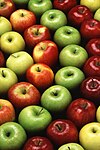Dumelow's Seedling
| 'Dumelow's Seedling' | |
|---|---|
 | |
| Cultivar | 'Dumelow's Seedling' |
| Origin | England, before 1800[1] |
Dumelow's Seedling is a cultivar of domesticated apple that originated at Shackerstone in Leicestershire where it was grown by Richard Dumeller in 1800. It is known by many other names including 'Dumelow's Crab', 'Wellington', 'Doncklaer', 'Beauty', and 'Belle de Vennes'. The fruit is not ready for harvest until October, being one of the last of the season, and keeps well into the next year. Though inferior for use as a dessert apple it cooks well and in early-20th century England was one of the most valuable varieties of cooking apple.
History[]
The variety was first raised by Richard Dumeller (or Dumelow) of Hop John's Hill near Shackerstone in Leicestershire.[2] The original tree had been growing there since at least 1800. It was first exhibited under the name Dumelow's Crab in 1818 and had become known as the Wellington by 1820 when it was exhibited at the Royal Horticultural Society.[1][3] The alternative name is believed to have arisen from its cultivation at Wellington, Shropshire though it was later incorrectly attributed to the Duke of Wellington under which name it has also been known.[4]
The apple is derived from the crossed with an unknown variety. Dumelow's Seedling is parent to the Hounslow Wonder, Cottenham Seedling, Baron Ward, Newton Wonder, Belvoir Seedling, Monarch and Lane's Prince Albert.[1] Dumelow's Seedling is known by more than 50 alternative names that include 'Dumelow's Crab', 'Wellington', 'Doncklaer', 'Beauty', and 'Belle de Vennes'.[1][3]
Description[]
The fruit is described as a medium "flat-round" and is typically around 52 mm (2.0 in) in height and 67 mm (2.6 in) in width.[1][5] The apples are whiteish-yellow with red mottling and the skin is tough. The fruit is very firm with a crisp, juicy flesh that is slightly yellow. It is said to cook well but for dessert use is inferior to red apples such as Baldwin or Sutton.[1][3] It was regarded in early 20th-century England as one of the most valuable varieties of cooking apple.[3] Sugar 12%, acid 12g/litre, vitamin C 4mg/100g.[6]
Dumelow's Seedling flowers in mid-May and is ready for harvest in early October.[1] The tree is quite productive in alternate years.[3] It is one of the last apples of the season and is said to keep well; retaining its flavour in storage until April and sometimes until the first rhubarb and gooseberry harvest is ready.[3][7][8]
The young wood of the tree is speckled and it is said to be resistant to canker.[8][9] The tree is said to be a strong grower, with an upright, round spread of somewhat drooping branches.[3] The bark is a light-brownish red with olive green and the leaves are relatively large and broad.[3]
References[]
- ^ a b c d e f g "Dumelow's Seedling", National Fruit Collection, retrieved 11 November 2015
- ^ GC & HTJ. 1897. p. 426. Retrieved 5 April 2019.
- ^ a b c d e f g h Beach, S.A.; Booth, N.O.; Taylor, O.M. (1905), "Dumelow", The apples of New York, 1, Albany: J. B. Lyon, pp. 112–113
- ^ Loudon, John Claudius (1835). The Gardener's Magazine and Register of Rural and Domestic Improvement. Longman, Rees, Orme, Brown and Green. pp. 180–1.
- ^ Morgan, Joan; Richards, Alison (2002). The New Book of Apples: The Definitive Guide to Apples, Including Over 2000 Varieties. Ebury. p. 179. ISBN 9780091883980. Retrieved 5 April 2019.
- ^ Obst und Garten 10/2020
- ^ Morgan, Joan; Richards, Alison (2002). The New Book of Apples: The Definitive Guide to Apples, Including Over 2000 Varieties. Ebury. p. 90. ISBN 9780091883980. Retrieved 5 April 2019.
- ^ a b The Encyclopædia Britannica, or, Dictionary of arts, sciences, and general literature. Adam & Charles Black. 1856. p. 716. Retrieved 5 April 2019.
- ^ The Florist, Fruitist, and Garden Miscellany. 1859. p. 245. Retrieved 5 April 2019.
External links[]
 Media related to Dumelow's Seedling at Wikimedia Commons
Media related to Dumelow's Seedling at Wikimedia Commons
- British apples
- Apple cultivars
